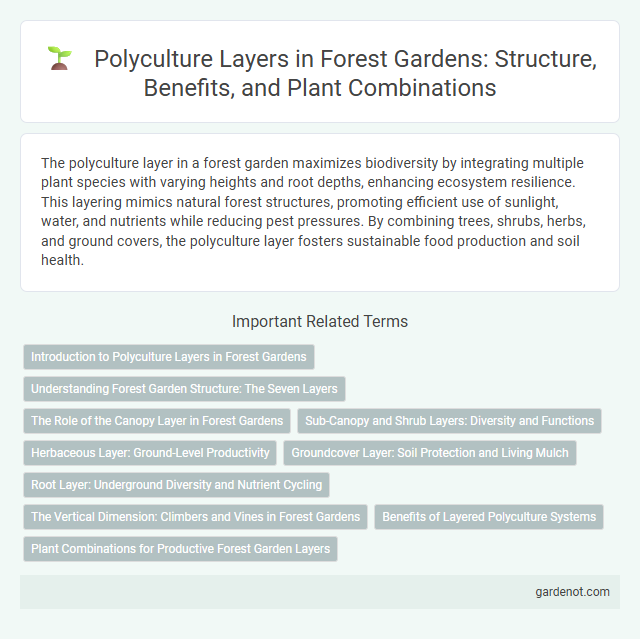The polyculture layer in a forest garden maximizes biodiversity by integrating multiple plant species with varying heights and root depths, enhancing ecosystem resilience. This layering mimics natural forest structures, promoting efficient use of sunlight, water, and nutrients while reducing pest pressures. By combining trees, shrubs, herbs, and ground covers, the polyculture layer fosters sustainable food production and soil health.
Introduction to Polyculture Layers in Forest Gardens
Polyculture layers in forest gardens include multiple strata such as canopy trees, understory shrubs, herbaceous plants, ground covers, root crops, and climbing vines that maximize space and biodiversity. These layers mimic natural forest ecosystems, enhancing nutrient cycling, pest control, and soil health by supporting diverse plant species with complementary functions. Implementing polyculture layers results in a resilient, productive system that sustains food production and ecosystem services year-round.
Understanding Forest Garden Structure: The Seven Layers
The polyculture layer in a forest garden integrates multiple plant species arranged vertically to mimic natural ecosystems, optimizing space and resource use. Understanding the seven layers--canopy, sub-canopy, shrubs, herbs, ground cover, root crops, and vines--enhances biodiversity and resilience in permaculture design. This layered structure supports nutrient cycling, pest control, and sustainable food production through diverse, complementary plant relationships.
The Role of the Canopy Layer in Forest Gardens
The canopy layer in forest gardens plays a critical role by providing shade that regulates temperature and moisture, creating a microclimate favorable for diverse understory plants. This layer, consisting primarily of tall fruit and nut trees, enhances biodiversity and supports ecosystem functions such as carbon sequestration and soil health improvement. Canopy trees also act as windbreaks, reducing erosion and protecting more delicate plants within the polyculture system.
Sub-Canopy and Shrub Layers: Diversity and Functions
The sub-canopy and shrub layers in a forest garden polyculture enhance biodiversity by providing varied habitats and food sources for wildlife, improving ecosystem resilience. These layers contribute to nitrogen fixation, pest control, and microclimate regulation, supporting overall plant health and productivity. Integrating fruit trees, nitrogen-fixing shrubs, and medicinal plants within these strata maximizes vertical space and nutrient cycling efficiency.
Herbaceous Layer: Ground-Level Productivity
The herbaceous layer in a forest garden's polyculture system enhances ground-level productivity by incorporating diverse, low-growing plants such as culinary herbs, medicinal plants, and ground covers that improve soil health and suppress weeds. This layer supports ecosystem functions including nutrient cycling, pollinator attraction, and moisture retention, crucial for sustaining overall garden resilience. Integrating nitrogen-fixing species and dynamic accumulators in the herbaceous layer boosts soil fertility, promoting vigorous growth in upper layers and maximizing yield in permaculture designs.
Groundcover Layer: Soil Protection and Living Mulch
The groundcover layer in forest gardens plays a critical role in soil protection by reducing erosion and retaining moisture, thus enhancing soil health. Living mulch plants like clover and creeping thyme suppress weeds, improve nutrient cycling, and increase biodiversity within the polyculture system. This layer fosters a resilient ecosystem by maintaining microclimates and supporting beneficial soil microorganisms essential for sustainable forest gardening.
Root Layer: Underground Diversity and Nutrient Cycling
The root layer in a forest garden plays a crucial role in underground diversity by supporting a complex network of different root systems that enhance soil structure and promote nutrient cycling. Deep-rooted plants access minerals from subsoil layers, while shallow-rooted species capture surface nutrients, creating a symbiotic environment that enriches the soil. This polyculture approach improves water retention, encourages beneficial microbial activity, and sustains plant health by continuously recycling organic matter below ground.
The Vertical Dimension: Climbers and Vines in Forest Gardens
Climbers and vines form a crucial polyculture layer in forest gardens, maximizing the vertical dimension by utilizing trellises, trees, and shrubs for support. These plants enhance biodiversity, improve space efficiency, and contribute to ecosystem resilience by creating microhabitats and increasing food production per square meter. Common examples include passionfruit, grapevines, and native honeysuckle, which provide fruit, nitrogen fixation, and habitat connectivity within the garden system.
Benefits of Layered Polyculture Systems
Layered polyculture systems in forest gardens enhance biodiversity by mimicking natural ecosystems, which improves pest resistance and soil health. These systems optimize space through vertical stratification, increasing overall productivity by combining trees, shrubs, herbs, and ground covers. The diverse plant layers create microclimates that conserve moisture and reduce erosion, contributing to sustainable and resilient food production.
Plant Combinations for Productive Forest Garden Layers
Polyculture layers in a forest garden combine diverse plant species such as nitrogen-fixing trees, shade-tolerant shrubs, and root crops to create mutually beneficial relationships that enhance soil fertility and maximize space. Integrating fruit trees with berry-producing shrubs and perennial herbs optimizes sunlight capture and supports pollinators, increasing overall yield. These plant combinations promote biodiversity, reduce pest pressure, and improve long-term productivity in sustainable agroforestry systems.
Polyculture layer Infographic

 gardenot.com
gardenot.com